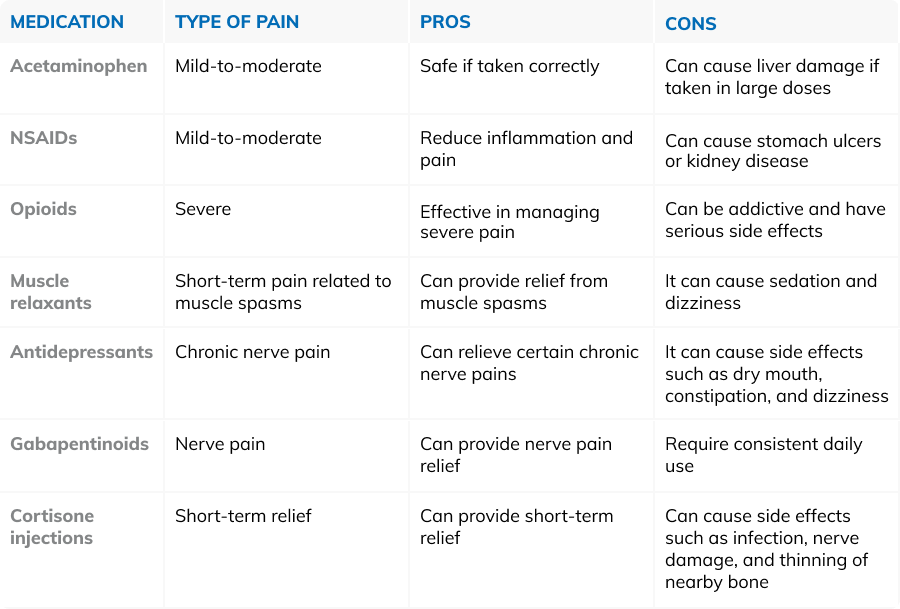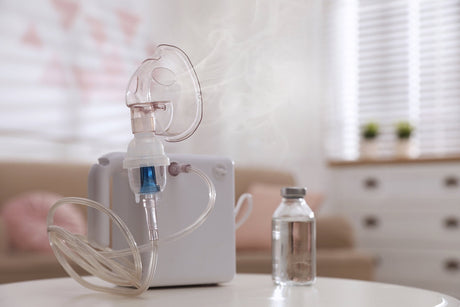Understanding Pain
Pain is a complex and subjective experience that can be caused by a variety of factors. The first step for interventional pain management is to understand the type of pain you are experiencing. There are two primary types of pain: chronic and acute. Acute pain is typically caused by an injury or surgery and is short-term, lasting for a few days or weeks. Chronic pain, on the other hand, is long-term and can last for months or even years. It is often associated with long-term illnesses such as arthritis or fibromyalgia.
Types of Pain
There are several different types of pain, usually depending on the cause of the pain, such as surgery, trauma, or chronic illness. It's also possible to feel more than one type of pain at any given time, but understanding what the cause is, and how to describe it may make it easier for you to discuss treatments with a healthcare practitioner.
Acute pain is sudden pain with a particular source. It lasts for a short period of time, up to six months, and will disappear once the cause of the pain has been treated. Acute pain can grow in intensity before it gets better. Common causes can include broken bones, surgery, childbirth, and injuries.
Chronic pain is more enduring and can last for many years, with varying degrees of severity. While chronic pain may be related to an injury or surgery, it can often have no discernable reason. Chronic pain needs to be managed to prevent it from impacting your quality of life. Symptoms of this type of pain can include muscle density, limited mobility, headaches, nerve pain, and fibromyalgia.
Some other pain conditions include nociceptive pain, caused by the stimulation of nociceptors in the body, which are pain receptors for tissue injury. Neuropathic pain is caused by damage to the nerves themselves and functional pain is pain that has no apparent cause. It’s often associated with conditions such as irritable bowel syndrome (IBS), fibromyalgia, and chronic fatigue syndrome.
Advanced Pain Management Techniques
There are several pain management techniques available, including medication, physical therapy, diet, and at-home pain management tools.
Pain Medications
Medications can be either over-the-counter or prescription and have different pros and cons. Over-the-counter medications such as acetaminophen and ibuprofen can effectively relieve mild to moderate pain. Prescription medications can also help manage severe pain but can be addictive and have serious side effects. Never take any pain reliever medication without first consulting with your medical practitioner.
Here's a glance at different medications used to treat pain:

Physical Therapy
Physical therapy is a non-invasive treatment option that can help alleviate pain and improve mobility. Physical therapists are experts in treating pain and its source. They will look for areas of weakness or stiffness that may be adding stress to the injury, and treat those areas with certain exercises to ease pain and help you move better.
In a physical therapy session, you may do a mix of low-impact aerobic training, strengthening exercises, pain relief exercises, and stretching. Physical therapy can also help improve posture and prevent future injuries. You may also want to find a pain management specialist or pain clinic in your area.
Topical pain treatments
Heat and cold therapy are two common methods used to alleviate pain. Heat therapy can help with morning stiffness or warm up muscles before activity, while cold therapy can reduce swelling and pain from a sprain or strain.
Utilizing ice on an aching back, inflamed knee, or twisted ankle can alleviate the discomfort and potentially lessen some of the swelling.
Heat aids in pain reduction by relaxing and loosening stiff muscles, and it encourages blood flow and nutrient delivery to expedite healing. Employ a heating pad or a damp towel heated in the microwave and place it on the painful spot. Alternatively, you can indulge in a warm bath or shower. Apply heat for a maximum of 20 minutes, three times daily. If you're using a heating pad, avoid sleeping with it.
By alternating between each thermal therapy, you simultaneously decrease inflammation and relax muscles, enhancing your likelihood of pain alleviation. Some individuals find that ice is most effective for their pain. Others prefer heat or a combination of heat and ice. Always consult your physician about what can help relieve pain.
Diet and Pain Management
Diet can also play a role in pain management. Certain foods can help reduce inflammation and alleviate pain. Anti-inflammatory foods such as berries, fatty fish, and green tea can offer natural relief. On the other hand, processed foods and foods high in sugar can worsen inflammation and pain.
Drinking plenty of water and other fluids can help keep your body hydrated and reduce pain. Chronic pain is associated with elevated weight status, risk of multi-morbidity, suboptimal dietary patterns, and diet quality.
Safety and Precautions
It’s important to recognize when home management isn’t enough and it’s time to consult a healthcare professional. Seek medical attention if your pain is the result of an injury or accident that may have caused substantial damage to your body, including severe or uncontrollable bleeding, broken bones, or head trauma. Other warning signs include fever, headache, neck stiffness, weakness, numbness, or tingling in one or both legs, and unintended weight loss. It’s always best to seek the assistance of a medical professional.
How to manage pain at home
Pain management at home requires a multifaceted approach. By understanding the nature of your pain, utilizing a combination of medication, therapy, and lifestyle changes, and knowing when to seek professional help, you can effectively manage your pain and improve your quality of life. Remember, you're not alone in this journey; support is always available.
FAQs:
Q: What is the best way to manage chronic pain?
Chronic pain can be managed through a combination of medication, physical therapy, and lifestyle changes. It’s important to work with a healthcare professional to develop a personalized treatment plan based on your specific needs.
Q: What are some common causes of pain?
Some common causes of pain include injuries, illnesses, and medical procedures. Pain can also be a symptom of an underlying condition such as arthritis or fibromyalgia.
Q: What are some natural ways to manage pain?
There are several natural ways to manage pain, including diet, exercise, and at-home pain management tools such as heat and cold therapy. Anti-inflammatory foods such as berries, fatty fish, and green tea can offer natural relief. Staying hydrated is also important in managing pain, as dehydration can worsen pain and slow recovery. Heat therapy can help with morning stiffness or warm up muscles before activity, while cold therapy can reduce swelling and pain from a sprain or strain.
As a leading supplier of durable and home medical equipment (DME and HME), ApriaHome sources and distributes a wide range of treatment solutions, including pain management products and solutions.
We're here to support you as you work toward your improved health and well-being. We strive to meet your ever-evolving healthcare requirements with individualized attention and premium quality treatment solutions.
Looking to add home medical supplies? Browse our premium solutions and let us help you get the most out of every day.
Looking for advice? Our helpful agents are on call at (800) 780-1508 between 8:00 am - 10:00 pm EST daily. Get in touch today.





